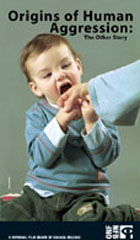
Origins of Human Aggression: The Other Story 2004
Distributed by National Film Board of Canada, 1123 Broadway, Suite 307, New York, NY 10010; 800-542-2164
Produced by DaVinci Productions
Directed by Jean-Pierre Maher
VHS, color, 50 min.
Adult
Adolescence, Child Development, Education, Parenting, Psychology, Sociology, Teacher Training
Date Entered: 04/20/2005
Reviewed by Hope Marie Cook, Curriculum Center Librarian, Eastern Connecticut State UniversityThis professionally produced documentary identifies the reasons for aggression in children, 0-5 years of age. What makes children turn into violent adults? Some researchers theorize that children are driven by innate dominance instincts. Others conclude that children learn violence by imitation. The age old argument of nature vs. nurture is one that has interested philosophers and researchers as they try diligently to describe why some children are prone to violent aggression. Further, there is evidence linking aggression and anger emotions in newborns.
This documentary reports that boys are at their worst physical aggression when they are in kindergarten and not in adolescence, as many would presume. Researchers have found that humans are most likely to resort to physical aggression around the age of two. Exploratory aggression begins at birth and as soon as a baby can stand they become capable of hitting. By two or three years of age the motor skills needed to engage in physically aggressive behavior are mastered and they can now cause injury. By the time a child is four years of age the aggression decreases. What accounts for the decrease? The development of “breaks” inhibits physical aggression or what some would term normal brain development. Through contact with others, children learn that there is a consequence for physical aggression. The pleasure of hitting someone doesn’t outweigh the pain of getting hit back. Also their new found ability to control anger and suppress aggressive acts in order to fit into the social environment assists children with controlling their behaviors. This documentary also touches on the importance of helping children express themselves through their words and the need to invest in the developmental education of young children.
A real gem for educators in child development, Origins of Human Aggression is filled with fascinating research findings. It will work well as a medium for further dialog and discussion with parents, educators and daycare providers. This resource is highly recommended with great potential for use in many library collections.